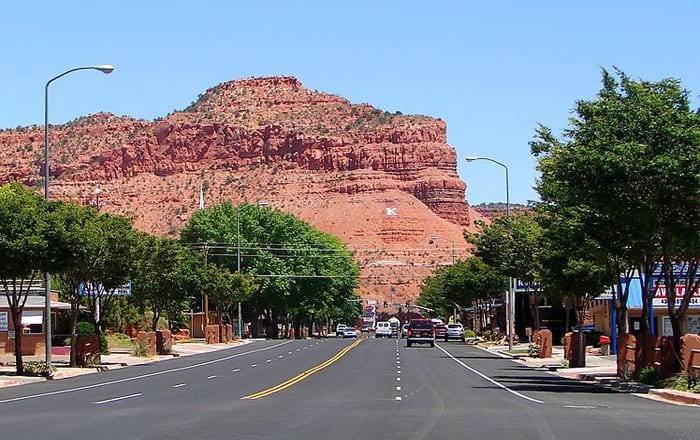
Written by Jeff Frey with Southern Utah News
The Coral Cliffs Golf Course once again dominated the Kanab City Council agenda on July 14, with more than 100 concerned citizens in attendance at the Kanab Library meeting.
Mayor Robert Houston prefaced the discussion by saying, “I don’t want to dwell on what has happened in the past regarding the golf course, but I want to focus on what can be done now with this- this.
Houston said he tried to work with Mike Schollian, who previously said he represented himself and his partners as owners of the course, but had very little success over the eight last months. Schollian was not present due to medical issues, according to Houston.
“I view the golf course as a community asset worth preserving, even though it is not currently an economic driver,” Houston said. “Two weeks ago, we presented Mr. Scholian with an action plan that we believed would keep the city on a viable course, but he came back with unacceptable demands for the city.”
Houston provided income and expenditure records for seven golf courses located in communities of relatively similar size in southern Utah. Four had losses between $30,000 and $60,000 a year, Richfield broke even, and Price and Moab made $49,000 and $90,000, respectively.
The Kanab course reportedly brought in $63,000, including $122,000 in expenses. At the previous meeting, Schollian said he could not afford to make up that difference with his own money and therefore wanted to close the golf course. The course has not received any maintenance so far this year and is not in playable condition at this time.
Houston estimated it would cost the city $110,000 a year to maintain and operate the course, generating about $65,000 in revenue after raising the fee for 18 holes from $15 to $20. Several people in the room estimated that revenue could be significantly higher than this estimate if the course was properly maintained, managed and promoted.
Council member Kirt Carpenter said, “The cost to the city does not include water at $70,000/year, electricity to pump water at $27,000/year and the use of a well to do this, with a replacement cost of $250,000.
However, the town supplied water to the Schollian Group for the first ten years as part of the deal made when the town was sold.
Councilmember Joe B. Wright sees it as a benefit to the community, but worries the town could find itself in the same predicament Schollian faces after a few years.
Most of the comments from those in attendance focused on ways to keep the course open through clubhouse volunteering and maintenance operations. The Pro-Shop employees were budgeted for an expense of $40,000.
Considerable effort and perhaps a cost estimated at at least $10,000 to restore the course to playable condition would be necessary. Once this goal was achieved, many felt they were aggressively promoting the golf course through campaigns by the Travel Council, the Kanab City website, local real estate agents, Best Friends, and state advertisements that brandished what Southern Utah has to offer could significantly increase gaming and revenue. It is also known that many regular local golfers have stopped playing on the course due to issues with maintenance and management.
Lynette Foster said two individuals, owning 390 shares of water between them, offered to donate those shares to the course to help cover water costs.
Statements from those in a position to know point to potential transplants to Kanab, as well as many tourists, asking if Kanab has a golf course and making their plans accordingly.
Although most participants felt the city should make an effort to maintain the golf course, others felt it was bailing out a bankrupt business or, at best, trying to prop up a fading hobby.
However, the question of where we are as a community and what we have to offer our residents, visitors and potential newcomers seems to have outweighed any doubts about keeping the course open.
Houston’s mayor reminded everyone that the city does not own the course. Unless Schollian and his partners (who remain unknown and perhaps should be identified and contacted, as some have suggested) agree to the terms and conditions set forth by the city, there is no way the city can intervene to keep the course operational.
In addition to the Coral Cliffs Golf Course discussion, Matt Brown presented tentative plans for the renovation and additions to the former Kanab Middle School located in the heart of downtown Kanab. The Kane County School District has been negotiating the transfer of ownership to Kane County and the City of Kanab of the 13-acre parcel for more than two years.
Plans include space for Kanab City offices, a senior center, a conference center, an outdoor recreation and festival area, an art gallery, a gymnasium renovation and an outdoor amphitheater of 400 seats, which would replace the existing Terrace room. The Heritage Museum would also undergo renovations at an estimated cost of $500,000.
The Utah State Community Impact Council would be asked for $10 million in the form of 60 percent as a grant and 40 percent as a low-interest loan. The loan would be repaid using the portion of the transient room tax money received locally from the state.
Several residents living on or near Navajo Dr. in the Kanab Creek Ranchos have complained about water runoff flooding their street and flowing through their homes, causing considerable damage. This is an ongoing problem that has only been exacerbated by recent heavy rains. The mayor said the heavy rain was “unusual” but promised to look into the situation.
Jeff Mosdell and Vicki Brackney have been named to the Kanab Library Board of Trustees.
Original article published on Southern Utah News.

